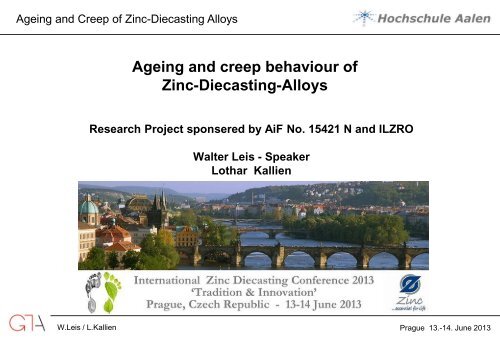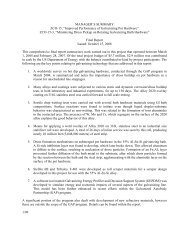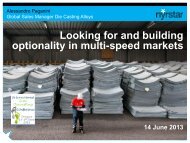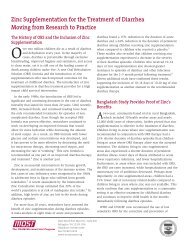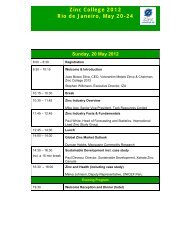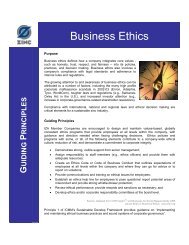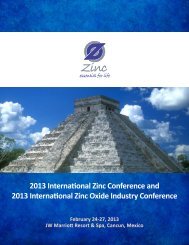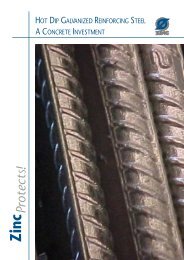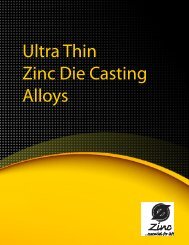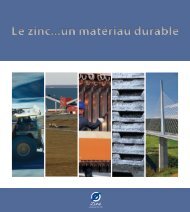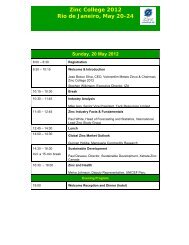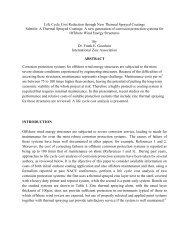Ageing and creep behaviour of Zinc-Diecasting-Alloys - International ...
Ageing and creep behaviour of Zinc-Diecasting-Alloys - International ...
Ageing and creep behaviour of Zinc-Diecasting-Alloys - International ...
Create successful ePaper yourself
Turn your PDF publications into a flip-book with our unique Google optimized e-Paper software.
<strong>Ageing</strong> <strong>and</strong> Creep <strong>of</strong> <strong>Zinc</strong>-<strong>Diecasting</strong> <strong>Alloys</strong><strong>Ageing</strong> <strong>and</strong> <strong>creep</strong> <strong>behaviour</strong> <strong>of</strong><strong>Zinc</strong>-<strong>Diecasting</strong>-<strong>Alloys</strong>Research Project sponsered by AiF No. 15421 N <strong>and</strong> ILZROWalter Leis - SpeakerLothar KallienW.Leis / L.KallienPrague 13.-14. June 2013
<strong>Ageing</strong> <strong>and</strong> Creep <strong>of</strong> <strong>Zinc</strong>-<strong>Diecasting</strong> <strong>Alloys</strong>Phase Diagram <strong>Zinc</strong> - AluminumZA84 weight % Aluminiuma: hexagonal structureeutectic 382°CW.Leis / L.KallienL. Kallien /W. Leisb, b´: kfz structurevery low solubility<strong>of</strong> Al in Znsources: Gottstein / IFAMPrague 13.-14. June 2013
<strong>Ageing</strong> <strong>and</strong> Creep <strong>of</strong> <strong>Zinc</strong>-<strong>Diecasting</strong> <strong>Alloys</strong>Microstructure <strong>of</strong> ZA8 <strong>and</strong> Z410ZA83 mm / 120°C / 55 m/smagnitude: 50 timesZ4103 mm / 120°C / 55 m/smagnitude: 50 timesW.Leis / L.KallienPrague 13.-14. June 2013
<strong>Ageing</strong> <strong>and</strong> Creep <strong>of</strong> <strong>Zinc</strong>-<strong>Diecasting</strong> <strong>Alloys</strong>Process parameters - Design Of Experiment - Effect on tensile strength25 m/s 40 m/s55 m/s200°C-6%160°C120°C+6%-5% +5%W.Leis / L.KallienPrague 13.-14. June 2013
stress [MPa]<strong>Ageing</strong> <strong>and</strong> Creep <strong>of</strong> <strong>Zinc</strong>-<strong>Diecasting</strong> <strong>Alloys</strong>Results from mechanical testscubic structureZ410 as cast, thickness 3 mmtensile strength ishardly dependingfrom internal defectsfracture elongation isstrongly dependingfrom internal defectshexagonal structurecold strengtheninginfluence <strong>of</strong>internal defectsstrain in %W.Leis / L.KallienPrague 13.-14. June 2013
<strong>Ageing</strong> <strong>and</strong> Creep <strong>of</strong> <strong>Zinc</strong>-<strong>Diecasting</strong> <strong>Alloys</strong>Statistical Results with DOE – As cast conditionDesign-Expert® S<strong>of</strong>tw areDesign-Expert® S<strong>of</strong>tw areRm Gusszust<strong>and</strong>446.25Rm Gusszust<strong>and</strong>446.25259.4X1 = A: W<strong>and</strong>stärkeX2 = B: Formtemperatur410380259.4X1 = B: FormtemperaturX2 = C: Geschw indigkeit390380Actual FactorsC: Geschw indigkeit = 40D: Prüftemperatur = 25Rm Gusszust<strong>and</strong>350320290260Actual FactorsA: W<strong>and</strong>stärke = 1.54D: Prüftemperatur = 25Rm Gusszust<strong>and</strong>3703603503403300.81.41.9A: W<strong>and</strong>stärke2.53.0 120140200180160B: Formtemperatur120140160B: Formtemperatur180200 2030605040C: GeschwindigkeitTensile strength as a function <strong>of</strong> wallthickness <strong>and</strong> die temperatureTensile strength as a function <strong>of</strong>die temperature <strong>and</strong> gate velocityW.Leis / L.KallienPrague 13.-14. June 2013
<strong>Ageing</strong> <strong>and</strong> Creep <strong>of</strong> <strong>Zinc</strong>-<strong>Diecasting</strong> <strong>Alloys</strong>Statistical Results with DOE – After artificial <strong>Ageing</strong>Design-Expert® S<strong>of</strong>tw areOriginal ScaleRm 105°, 24h359.25Design-Expert® S<strong>of</strong>tw areOriginal ScaleRm 105°, 24h359.25219X1 = A: W<strong>and</strong>stärkeX2 = B: FormtemperaturActual FactorsC: Geschw indigkeit = 40D: Prüftemperatur = 25Rm 105°, 24h420370320270220219X1 = A: W<strong>and</strong>stärkeX2 = D: PrüftemperaturActual FactorsB: Formtemperatur = 160C: Geschw indigkeit = 40Rm 105°, 24h4203703202702200.51.01.52.0A: W<strong>and</strong>stärke2.53.0 120140200180160B: Formtemperatur-35-525D: Prüftemperatur55853.02.50.51.01.52.0A: W<strong>and</strong>stärkeTensile strength as a function <strong>of</strong> wallthickness <strong>and</strong> die temperatureTensile strength as a function <strong>of</strong> wallthickness <strong>and</strong> testing temperatureW.Leis / L.KallienPrague 13.-14. June 2013
<strong>Ageing</strong> <strong>and</strong> Creep <strong>of</strong> <strong>Zinc</strong>-<strong>Diecasting</strong> <strong>Alloys</strong>Tensile strength as a function <strong>of</strong> process parameters - Z410W.Leis / L.KallienPrague 13.-14. June 2013
<strong>Ageing</strong> <strong>and</strong> Creep <strong>of</strong> <strong>Zinc</strong>-<strong>Diecasting</strong> <strong>Alloys</strong>Tensile strength as a function <strong>of</strong> process parameters - ZA80,8 mm1,5 mmmicro structure isinfluenced bysolidification time3,0 mmW.Leis / L.KallienPrague 13.-14. June 2013
<strong>Ageing</strong> <strong>and</strong> Creep <strong>of</strong> <strong>Zinc</strong>-<strong>Diecasting</strong> <strong>Alloys</strong>Tensile strength as a function <strong>of</strong> test temperature - Z410W.Leis / L.KallienPrague 13.-14. June 2013
<strong>Ageing</strong> <strong>and</strong> Creep <strong>of</strong> <strong>Zinc</strong>-<strong>Diecasting</strong> <strong>Alloys</strong>Tensile strength at +23°C <strong>and</strong> Center-Point-Conditions after natural ageing400Z410Tensile strength Rm in MPa375350325300275250225Mean values at RTthickness 1,5 mm200ageing 1 conditionas cast 3 weeks 6 weeks 3 month 6 month 1 year 2 years 20 yearsW.Leis / L.KallienPrague 13.-14. June 2013
<strong>Ageing</strong> <strong>and</strong> Creep <strong>of</strong> <strong>Zinc</strong>-<strong>Diecasting</strong> <strong>Alloys</strong>Comparison between natural <strong>and</strong> artifical ageing at Center-Point-Conditions <strong>and</strong> RT23 °C: Artifical <strong>Ageing</strong>W.Leis / L.KallienPrague 13.-14. June 2013
<strong>Ageing</strong> <strong>and</strong> Creep <strong>of</strong> <strong>Zinc</strong>-<strong>Diecasting</strong> <strong>Alloys</strong>Z410 High temperature ageing 24 h400Tensile strength vs <strong>Ageing</strong> temperaturetensile strength in MPa300200100Z410thickness 1,5 mmageing time 24 h00 50 100 150 200ageing temperature in °CW.Leis / L.KallienPrague 13.-14. June 2013
<strong>Ageing</strong> <strong>and</strong> Creep <strong>of</strong> <strong>Zinc</strong>-<strong>Diecasting</strong> <strong>Alloys</strong>Z410 Long time ageing400Tensile strength vs <strong>Ageing</strong> timetensile strength in MPa350300250200150100500Z410thickness 1,5 mmageing temperature 105°C0 200 400 600 800 1000ageing time in hW.Leis / L.KallienPrague 13.-14. June 2013
<strong>Ageing</strong> <strong>and</strong> Creep <strong>of</strong> <strong>Zinc</strong>-<strong>Diecasting</strong> <strong>Alloys</strong>Yield strength after artifical ageing with 65°C, 85°C und 105°C, 24h at -35°C, 23°C <strong>and</strong>+85°C, 3 wall thicknesses <strong>and</strong> Center-Point-ConditionsYield strength R p0,2 in MPa .400380360340320300280260240220200180Yield strength R p0,2 after artifical ageing0,8/-35 1,5/-35 3,0/-35 0,8/RT 1,5/RT 3,0/RT 0,8/85 1,5/85 3,0/85as cast 65°C/24h 85°C/24h 105°C/24hCenter-Point-ConditionsZ410Z410W.Leis / L.KallienPrague 13.-14. June 2013
Hardness [HB]<strong>Ageing</strong> <strong>and</strong> Creep <strong>of</strong> <strong>Zinc</strong>-<strong>Diecasting</strong> <strong>Alloys</strong>Hardness – <strong>Ageing</strong> <strong>behaviour</strong>130Z410 natural ageing1201101009080120°C 160°C200°C mean value0 30 60 90 120 150 180 210 240 270 300 330 360<strong>Ageing</strong> time in daysW.Leis / L.KallienPrague 13.-14. June 2013
<strong>Ageing</strong> <strong>and</strong> Creep <strong>of</strong> <strong>Zinc</strong>-<strong>Diecasting</strong> <strong>Alloys</strong>Fracture Elongation Comparision between Z400, Z410 <strong>and</strong> Z4301210as cast artifical ageing 105°C / 24 hFracture Elongation in %86420Z400 Z410 Z430Die casting defects have a very strong influence on fracture elongationFracture elongation increases with ageing timeW.Leis / L.KallienPrague 13.-14. June 2013
<strong>Ageing</strong> <strong>and</strong> Creep <strong>of</strong> <strong>Zinc</strong>-<strong>Diecasting</strong> <strong>Alloys</strong><strong>Ageing</strong> <strong>behaviour</strong> <strong>of</strong> Z400, Z410, Z430 <strong>and</strong> ZA8Production parameters at Center-Point-ConditionsW.Leis / L.KallienPrague 13.-14. June 2013
<strong>Ageing</strong> <strong>and</strong> Creep <strong>of</strong> <strong>Zinc</strong>-<strong>Diecasting</strong> <strong>Alloys</strong><strong>Ageing</strong> <strong>behaviour</strong> <strong>of</strong> ZA8W.Leis / L.KallienPrague 13.-14. June 2013
<strong>Ageing</strong> <strong>and</strong> Creep <strong>of</strong> <strong>Zinc</strong>-<strong>Diecasting</strong> <strong>Alloys</strong><strong>Ageing</strong> <strong>behaviour</strong> <strong>of</strong> ZA8W.Leis / L.KallienPrague 13.-14. June 2013
<strong>Ageing</strong> <strong>and</strong> Creep <strong>of</strong> <strong>Zinc</strong>-<strong>Diecasting</strong> <strong>Alloys</strong><strong>Ageing</strong> <strong>behaviour</strong> <strong>of</strong> ZA8W.Leis / L.KallienPrague 13.-14. June 2013
<strong>Ageing</strong> <strong>and</strong> Creep <strong>of</strong> <strong>Zinc</strong>-<strong>Diecasting</strong> <strong>Alloys</strong><strong>Ageing</strong> <strong>behaviour</strong> <strong>of</strong> ZA8W.Leis / L.KallienPrague 13.-14. June 2013
<strong>Ageing</strong> <strong>and</strong> Creep <strong>of</strong> <strong>Zinc</strong>-<strong>Diecasting</strong> <strong>Alloys</strong>Creep <strong>behaviour</strong><strong>creep</strong> Dehnung strain typical <strong>creep</strong><strong>behaviour</strong>steady state<strong>creep</strong>stationäresKriechen<strong>creep</strong> <strong>behaviour</strong><strong>of</strong> zincCreep mechanism isself diffusion <strong>of</strong> Zn,thermal activated(Arrhenius law)timeZeit tW.Leis / L.KallienPrague 13.-14. June 2013
<strong>Ageing</strong> <strong>and</strong> Creep <strong>of</strong> <strong>Zinc</strong>-<strong>Diecasting</strong> <strong>Alloys</strong>Effect <strong>of</strong> the thermal activation by Arrhenius law: With a temperature <strong>of</strong> 105°C thevelocity <strong>of</strong> the diffusion under <strong>creep</strong> is 3300 times faster than at room temperature!Effect <strong>of</strong> temperatureyCeQkT5.000Arrhenius-Factor4.0003.0002.0001Activation energy forself diffusion <strong>of</strong> ZnQ = 94 kJ/mol100 640 33001.000020 30 40 50 60 70 80 90 100 110Temperature in °CW.Leis / L.KallienPrague 13.-14. June 2013
<strong>Ageing</strong> <strong>and</strong> Creep <strong>of</strong> <strong>Zinc</strong>-<strong>Diecasting</strong> <strong>Alloys</strong>Creep <strong>behaviour</strong> at RT - linear scale2,01,6Z 410 1,5 mm105°C / 24 hy = 0,0335x 0,5526<strong>creep</strong> strain in %1,20,8y = 0,0207x 0,49090,40,0y = 0,0139x 0,38270 200 400 600 800 1000 1200 1400 1600 1800 2000time in h88,7 MPA 65,4 MPA 40,7 MPAW.Leis / L.KallienPrague 13.-14. June 2013
<strong>creep</strong> strain in %<strong>Ageing</strong> <strong>and</strong> Creep <strong>of</strong> <strong>Zinc</strong>-<strong>Diecasting</strong> <strong>Alloys</strong>Creep <strong>behaviour</strong> at RT - log. scaleKriechdehnung in %10,001,000,10the gradient ishardly dependingfrom stressy = 0,0335x 0,5526R 2 = 0,9975y = 0,0139x 0,3827R 2 = 0,9944Z 4101,5 mmy = 0,0207x 0,4909R 2 = 0,99950,011 10 100 1.000 Zeit in h 10.00088,7 MPA 65,4 MPA 40,7 MPAtime in hCreep behavior after artificial ageing (105°C / 24 h) (log. Scale)W.Leis / L.KallienPrague 13.-14. June 2013
<strong>creep</strong> rate in %/h<strong>Ageing</strong> <strong>and</strong> Creep <strong>of</strong> <strong>Zinc</strong>-<strong>Diecasting</strong> <strong>Alloys</strong>Creep velocity at RT (log. scale) Z400time in hW.Leis / L.KallienPrague 13.-14. June 2013
<strong>creep</strong> strain in %<strong>Ageing</strong> <strong>and</strong> Creep <strong>of</strong> <strong>Zinc</strong>-<strong>Diecasting</strong> <strong>Alloys</strong>Creep behavior <strong>of</strong> Z410 under different ageing conditionsKriechdehnung in %1,000,10Z 4103,0 mmRT / 77 MPay = 0,0309x 0,4836R 2 = 0,9994y = 0,0349x 0,4104R 2 = 0,9995y = 0,0252x 0,428R 2 = 0,9997y = 0,0255x 0,4394R 2 = 0,9998Gradient isdepending fromageing time0,011 10 100 Zeit in h 1.000as cast 105°/8h 105°/24h 105°/101htime in hW.Leis / L.KallienPrague 13.-14. June 2013
<strong>Ageing</strong> <strong>and</strong> Creep <strong>of</strong> <strong>Zinc</strong>-<strong>Diecasting</strong> <strong>Alloys</strong>Creep rate at RT for Z410 as a function <strong>of</strong> ageing time <strong>and</strong> thickness0,10000Creep rate vs <strong>Ageing</strong> timestress 76 MPaartificially aged at 105°CUmi 21 years0,01000<strong>creep</strong> rate in %/h0,00100thickness 1,5 mmthickness 3,0 mm0,000101 % per year<strong>creep</strong> rate calculated at 1 % <strong>creep</strong> strain0,000011 10 100 1.000 10.000ageing time in hW.Leis / L.KallienPrague 13.-14. June 2013
<strong>Ageing</strong> <strong>and</strong> Creep <strong>of</strong> <strong>Zinc</strong>-<strong>Diecasting</strong> <strong>Alloys</strong>Creep behavior <strong>of</strong> ZA8 at RT - Umicore samples2,0<strong>creep</strong> strain in %1,61,20,80,4ZA8 UmicoreNatural ageing: 6 JahreArtificial ageing: 105°C / 24 hy = 0,0657x 0,5360 y = 0,0269x 0,50530,9% <strong>creep</strong> strainafter 1000 h by astress <strong>of</strong> 70 MPay = 0,0190x 0,35480,00 200 400 600 800 1000 1200 1400 1600 1800 2000time in hZA8-93,8 MPa ZA8-68,1 MPa ZA8-42,5 MPaCreep behavior <strong>of</strong> ZA8 after artificial ageing (105°C / 24 h) (log. scale)W.Leis / L.KallienPrague 13.-14. June 2013
<strong>creep</strong> strain in %<strong>Ageing</strong> <strong>and</strong> Creep <strong>of</strong> <strong>Zinc</strong>-<strong>Diecasting</strong> <strong>Alloys</strong>Creep behavior <strong>of</strong> ZA8 at RT - University Aalen samples0,5% <strong>creep</strong> strain after1000 h <strong>and</strong> 70 MPatime in hW.Leis / L.KallienPrague 13.-14. June 2013
<strong>Ageing</strong> <strong>and</strong> Creep <strong>of</strong> <strong>Zinc</strong>-<strong>Diecasting</strong> <strong>Alloys</strong>Creep behavior <strong>of</strong> ZA8 (log. scale)<strong>creep</strong> strain in % a1010,1y = 0,0223x 0,5994y = 0,0154x 0,5060ZA8105°C / 24hy = 0,0075x 0,4656 y = 0,0034x 0,66280,010,001y = 0,0013x 0,6482Die Steigung istabhängig von derAlterung1 10 100 1.000 10.000time in hZA8-94,5 MPa RT ZA8-69,2 MPa RT ZA8-43,1 MPa RTZA8-12 MPa +90°CZA8-12 MPa +85°CW.Leis / L.KallienPrague 13.-14. June 2013
<strong>Ageing</strong> <strong>and</strong> Creep <strong>of</strong> <strong>Zinc</strong>-<strong>Diecasting</strong> <strong>Alloys</strong>Calculated <strong>creep</strong> lines at RT (lin. scale) in %Calculated <strong>creep</strong> strain at RT – Z410time in hW.Leis / L.KallienPrague 13.-14. June 2013
<strong>Ageing</strong> <strong>and</strong> Creep <strong>of</strong> <strong>Zinc</strong>-<strong>Diecasting</strong> <strong>Alloys</strong>Conclusion• The ageing <strong>behaviour</strong> <strong>of</strong> <strong>Zinc</strong> die casting alloys is activated at room temperature<strong>and</strong> caused by a very low solubility <strong>of</strong> aluminium in zinc at room temperature• The mechanism <strong>of</strong> ageing is diffusion. The diffusion process starts immediatelyafter ejection from the die• The process <strong>of</strong> ageing at room temperature is finished after 1 year for Z410, forZ400 after half a year <strong>and</strong> for Z430 after 2 years. The loss <strong>of</strong> tensile strength <strong>and</strong>yield strength amounts to 15%• The natural ageing can be accelerated by an artificial ageing at 105°C over24 hours <strong>and</strong> should not be higher than 105°C• The mechanical properties <strong>of</strong> <strong>Zinc</strong> die casting alloys after ageing are very high incomparison to aluminium- und magnesium alloys• The natural ageing behavior <strong>of</strong> ZA8 needs more time than Z410 needs• The loss <strong>of</strong> tensile strength <strong>of</strong> ZA8 is stronger compared with Z410W.Leis / L.KallienPrague 13.-14. June 2013
<strong>Ageing</strong> <strong>and</strong> Creep <strong>of</strong> <strong>Zinc</strong>-<strong>Diecasting</strong> <strong>Alloys</strong>Conclusion• The natural ageing <strong>of</strong> ZA8 can be accelerated through an artificial ageing• The <strong>creep</strong> <strong>behaviour</strong> <strong>of</strong> zinc die casting alloys is caused by self diffusion <strong>of</strong> zinc<strong>and</strong> is also thermal activated by Arrhenius law• Creep in zinc die casting alloys is also a function <strong>of</strong> time, that means, the <strong>creep</strong>rate decreases always by a constant stress up to 1% <strong>creep</strong> elongation (primary<strong>creep</strong> through strengthening)• No secondary <strong>creep</strong> could be observed, the <strong>creep</strong> behavior can be calculated upto 1% <strong>creep</strong> strain with a power function• After a <strong>creep</strong> strain <strong>of</strong> 1% the <strong>creep</strong> rate increases (destrengthening)• The mechanical properties <strong>of</strong> <strong>Zinc</strong> die casting alloys after ageing are very high incomparison to aluminium- und magnesium alloysW.Leis / L.KallienPrague 13.-14. June 2013


